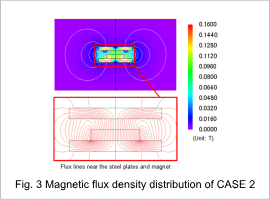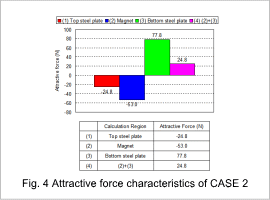Overview
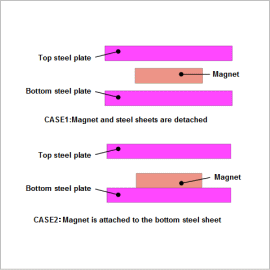
In order to understand the phenomena where the magnet and magnetic material attract each other, it is helpful to visualize the magnetic flux flowing through the air. Using a magnetic field analysis makes it easy to visualize and understand these phenomena.
This Application Note explains how to obtain the magnetic flux density distribution and attractive force generated between a steel plate and a magnet.
Attractive Force Characteristics of CASE 1
The magnetic flux density distribution for CASE 1 is shown in fig. 4.1, and its attractive force characteristics are shown in fig. 4.2. The attractive force acting in the positive direction on the Y-axis is set to positive.
The relative positions of the magnet and steel plate allow the magnetic flux to be vertically symmetrical, meaning that the forces acting on the top steel plate and the bottom steel plate are the same, and almost no force is acting on the magnet.
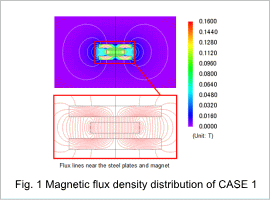
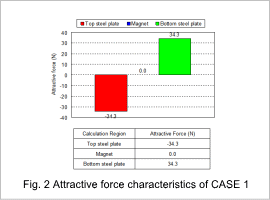
Attractive Force Characteristics of CASE 2
The magnetic flux density distribution for CASE 2 is shown in fig. 3, and its attractive force characteristics are shown in fig. 4. In fig. 4, (4) is a value that represents the sum of the attractive forces of (2) Magnet and (3) Bottom steel plate. The attractive force acting in the positive direction on the Y-axis is set to positive.
In CASE 2 the magnet is touching the bottom steel plate, so the magnetic flux density is higher in the bottom steel plate than in the top steel plate, and the attractive force between the magnet and the bottom steel plate is larger than between the magnet and the top steel plate. This is why the magnet’s attractive force in fig. 4 is shown acting in the negative direction, and the sum of (1) and (2) is equal to (3). (1) and (4) are also equal, so it is possible to confirm that the attractive force that the attractive force acting on the magnet and the bottom steel plate has been obtained correctly.
